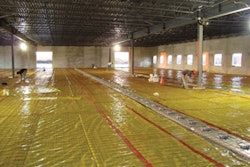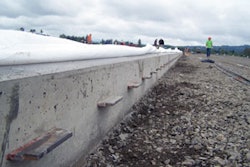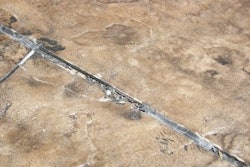Leading edge distress is a commonly claimed but superficial defect present in some types of residential concrete slabs and foundations. It can also lead to homeowner distress, where a concerned homeowner or association may believe - or be led to believe - there are structural defects in the foundations of their homes. While this is possible, it's more likely that the situation is cosmetic, not structural.
However, plaintiffs in concrete defect litigation often claim leading edge distress is a sign of defective concrete, including "salt" or "sulfate" attack. Let's allay those fears and allegations with an explanation of why this problem occurs and what can or should be done to fix it.
Leading edge distress occurs at the forward edge of post-tensioned (PT) garage slabs, along the isolation joint, where the slab adjoins the driveway apron. Also known as "scaling," a common symptom is the loss of surface paste to expose small aggregate particles or of sand within the concrete mass. Rarely, coarse aggregate particles may also be visible.
Plaintiff allegations notwithstanding, it's been demonstrated, through a series of tests and investigations, that the most common cause of leading edge distress is the combination of the methods used to finish the concrete, exposure to the elements and traffic. This condition occurs whether there is sulfate exposure or not and whether there is carbonate exposure or not. We've seen this in many environments and have found that leading edge distress is not an indicator of a structural defect or chemical attack. It poses no long-term danger to the slab.
Here's what happens: Bleed water can drain off of the PT slab only from the leading edge, as form boards or concrete curbs enclose the other three edges of the garage slab. When the surface of the garage slab is troweled to obtain a smooth finish, bull floating operations drag all of the bleed water along the floated surface toward the leading edge and rework it into the surface paste. This concentrates and redistributes the watery soup, layer by layer, to the leading edge surface, preserving layers of weaker, locally higher water-to-cementitious-ratio paste. Poor timing, edge tooling operations and additional hard troweling in this region can further rearrange this material along the leading edge, leaving the surface weaker. This can be worsened by poor timing of construction operations or other construction-related practices.
As a result, the concrete at the surface near the leading edge is not as strong as the concrete farther back in the garage. In addition, the portion of the leading edge between the face of the garage door and the driveway joint sees the greatest amount of traffic, mechanical stress, wetting and drying cycles, heating and cooling, and the like. Often weather and drainage conditions lead to the crystallization of salts as well.
A shallow depression, or pond, just back from the edge is also common because of edge tooling operations with a reversed slope that permit ponding and prevent drainage off of the edge. Sprinklers and rainwater on the garage door and driveway and garage slab washing operations can leave ponds of water that lead to scaling along the leading edge, with the layers flaking off.
For a less expensive fix we recommend surface grinding, combined with a provision for improved drainage to prevent or reduce ponding. The installation of a coating, with or without grinding the area, can also effectively remedy the blemish associated with the leading edge scaling, at a higher cost.
Another strategy is to remove an approximately 12-inch-wide strip of leading edge to a depth of 1/4 or 3/8 inch and replace it with a good quality, prepackaged repair mortar with early strength properties similar to the concrete in place. The removal should be rectilinear in shape and the edge cuts vertical, perpendicular to the finish surface.
In conclusion: When questions or allegations arise regarding the cause of leading edge distress on garage slabs, be forearmed with the knowledge that this is not uncommon. Generally it is cosmetic in nature and rarely indicates an underlying structural defect.


















